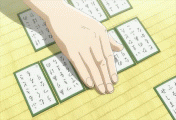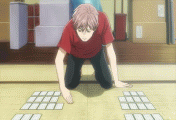Hyakunin Isshu Karuta is the focus of the Chihayafuru story. It is a traditional Japanese card game that involves considerable physical and mental skill.
Name Origin[]
Hyakunin Isshu (百人一首, literally "one hundred poets, one poem each"), also referred to as Hundred Poets, is a traditional anthology style of compiling Japanese waka poetry where each contributor writes one poem for the anthology.
Karuta is a loanword from the Portuguese word carta, meaning "card," which was imported into Japan in the 16th century. In Japan, Western playing cards evolved into two types of games: card-matching Karuta and poker-like Hanafuda. One of the more popular variants of the former is Ogura Hyakunin Isshu Uta-Garuta, named after the Ogura Hyakunin Isshu collection; it is this game that Chihayafuru focueses on.
How to Play[]
Competitive karuta is played between two players, with a card reader (who reads out the card poems) and a judge to assist. The objective is for the players to clear the cards on their territory before their opponent.
The game uses two types of cards:
- Yomifuda ("reading cards"): One hundred reading cards with a figure of a person, his or her name and a complete poem by him or her on each one
- Torifuda ("grabbing cards"): One hundred playing cards, each corresponding to a yomifuda but with only the ending lines of their corresponding poem
Each player receives 25 random torifuda and arranges them neatly face up in three rows on their territory. Each player's territory is 87 cm wide, with a 3 cm long gap between the two territories. Thus, 50 out of the 100 cards will be in play, leaving 50 cards out of play; these are referred to as "dead cards" or "ghost cards."
The players have 15 minutes to memorize the positions of the cards. Once the time ends, the reader recites an opening poem (one that is not part of the collection that the poems on the cards are from) to let the players familiarize themselves with the reader's voice.
After the opening poem, the reader draws a yomifuda at random and reads out the poem on it. The players then race to find and touch the corresponding torifuda as soon as they recognize which poem is being read. The first player to touch the card wins it and takes it off the field. If a player takes the card from their opponent's territory, that player can send one of their cards to their opponent. If a player touches a card when a ghost card is being read, or touches a card not in the same territory as the correct card, the player incurs a penalty and the opponent can send one of their cards to the player. There is no penalty if a player touches a wrong card in the same territory as the correct card.
The game continues with the reader reading the next yomifuda and the players racing to touch the corresponding torifuda until the game is over, which occurs when one player's field is empty. The player whose field is empty is the winner.
Glossary[]
Basics[]
- Ji-jin (Player's Territory)
- Formation of cards on the player's own side. Jijin cards are easier to win for shorter distance. Players usually separate them into right and left for ease of flicking.
- Teki-jin (Opposite Territory)
- Formation of cards on the opposite side. Tekijin cards are harder to win for longer distance and reversed letters.
- Kara-fuda (Void Cards)
- "Dead Cards"/"Ghost Cards." Only 50 cards are used in a game; the remaining 50 cards that are not in play become Kara-fuda. Touching cards when a Kara-fuda is read is penalized with Otetsuki.
- Joka (Opening Poem)
- The Introductory poem which is read at the beginning of game, which does not belong to the collection of poems that the poems on the cards come from and serves to familiarize the players with the reader's voice. For Ogura Hyakunin Isshu, the opening poem is Now the Flower Blooms.
- Dokushu (Reader)
- The reciter who reads poems. Note that the dokushu is not a referee; karuta is played without referees, and disputes between players should be solved by the agreement of the players themselves.
Rules[]
- Otetsuki (False Touch)
- Fault. When a player touches the wrong card on the opponent's side, or touches any card when a ghost card is read, the opponent can send one of his or her cards to the player's side as a penalty.
- Okuri-fuda (Sending Cards)
- When a player wins a card from the opposite territory, or when the opponent gets penalized, the player sends one card from his or her own territory. The opponent must place the sent card in his or her territory in any location he or she wants. The choice of which card to send is important for constructing a strategically favorable formation.
- Daburu or Dabu (Double)
- (A loanword from English)
- When a player makes Otetsuki in the opponent's territory when the opponent wins a card from player's territory. Two Otetsuki in one turn is also a double penalty.
- Seimu (Same)
- (A loanword from English)
- 1. Tie. The situation of when both players have the same amount of cards.
- 2. The situation of when both players touch correct card at the same time.
- Unmei-sen (Fatal Game)
- The situation of Seimu (tying) with only one card remaining. Since it is almost impossible to win the opponent's last card in this situation, the result of the game is simply dependent on dokushu's next card; hence "fatal."
- Genpei-sen (Genpei War)
- A karuta match that uses all one hundred cards. Unofficial team play rule.
Cards[]
- Tomo-fuda (Like Cards)
- Cards which begin with same syllable. The "Chi-ha-ya-fu-ru" card has two Tomo-fuda, Chi-gi-ri-ki-no and Chi-gi-ri-o-ki-shi.
- Kimari-ji (Unique Syllable)
- The first several syllables with which players can be sure which card to take. For example, the unique syllables of "Chi-ha-ya-fu-ru" are "Chi-ha-", for its other Tomo-fuda cards begin with Chi-gi-.
- 1-ji Kimari, 2-ji Kimari... (One-Syllable Card, Two-Syllable Card...)
- The cards that begin with one (two, three,...) unique syllable(s). The Chi-ha-ya-fu-ru card is a Two-Syllable Card. Chi-gi-ri-ki-no and Chi-gi-ri-o-ki-shi are Four-Syllable Cards.
- Ooyama-fuda (Long Shot Cards)
- Another name for Six-Syllable Cards. Players often wait with Kakoi-te, since dokushu takes a pose after the fifth syllable.
- Kimariji-Henka (Unique-syllable Shift)
- The Unique Syllables of a card can change as the game proceeds. For example, Chi-ha-ya-fu-ru changes from a Two-Syllable Card to a One-Syllable Card once Chi-gi-ri-ki-no and Chi-gi-ri-o-ki-shi have both been read.
- Mu-Su-Me-Fu-Sa-Ho-Se ("Girls, dry the bunches!")
- A famous mnemonic for learning One-Syllable Cards. This mnemonic contains the syllables that all the One-Syllable Cards begin with.
Techniques[]

Kakoi-te (Covering Hand)
- Kakoi-te (Covering Hand)
- A technique to cover a card with the player's palm and fingers until the Unique Syllable is determined. The other player has to break the cover to win it. In Chihayafuru anime episode 4, Chihaya tried to break through Yasuda's cover, only to be blocked by his big palm.

Watari-te (Cross Hand)
- Watari-te (Cross Hand)
- Player is not penalized with Otetsuki when he/she flicks two directions under a certain condition. Yusei took a measure to contain Chihaya's Cross Hand tactic in episode 8.
- A technique to pull player's hand back away from opposite territory to flick their own territory. In some cases, aiming a card with Modori-te is faster than aiming the card directly.

Tsuki (Thrust)
- Tsuki (Thrust)
- A technique to attack opponent's guarded inner low area.
- Seme-karuta (Offensive Karuta)
- The play style of focusing on the opposite territory. Technical features are, for example, 1. Aim Cross Hand to opposing Like Cards. 2. Send Like Cards of shorter Unique Syllables for aiming Back Hand. 3. Aim at right-hander's weak point, opponent's lower right area, for first. etc.
- Mamori-karuta (Defensive Karuta)
- The play style of focusing on player's own territory. Technical features are, for example, 1. Split up Like Cards to prevent opponent's Cross Hand. 2. Send Like Cards of Three-Syllable Cards to lure opponent's faults. 3. Aim at own lower right area for first, etc.
Example of Unique-syllable Shift from Chihayafuru Anime Episode 4[]
In the Chihaya's match against Yasuda, one of Chi-ha-ya-fu-ru's Like Cards, Chi-gi-ri-o-ki-shi, was a Ghost Card and not in the game. Yasuda won the other Like Card, Chi-gi-ri-ki-no, with admirable aggressive technique at the early stage of the game. Ironically, this made the Chi-ha-ya-fu-ru a One Syllable Card, which Chihaya excels at. The tide of the end of the game might have been different if Chi-gi-ri-ki-no wasn't taken at the beginning.

